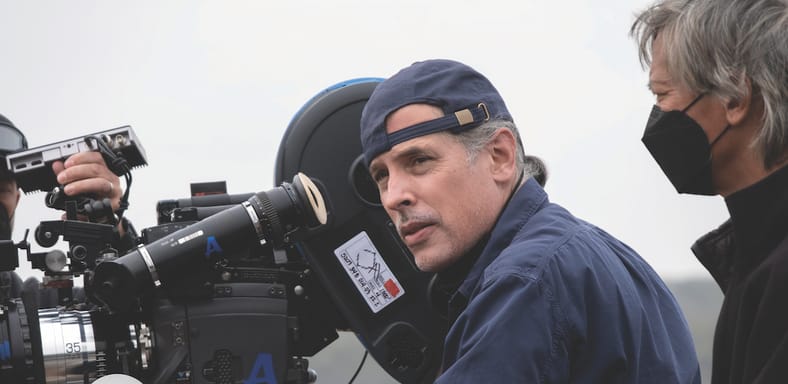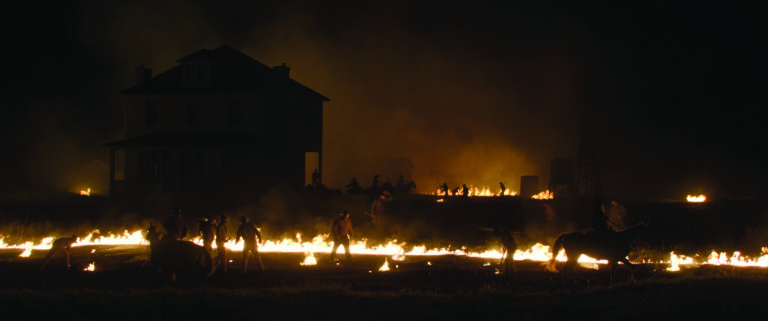
Rodrigo Prieto is a master of versatility: This year, films he’s shot include Greta Gerwig’s Barbie, a rhapsody in pink, and Martin Scorsese’s new Killers of the Flower Moon, a horrific and magisterial story of a culture under attack. The films couldn’t look more different, and couldn’t be more immersed in their own aesthetics, honed by Prieto’s process of discovery and invention.
The Mexican-born cinematographer first gained international attention for the ninth film he shot, Alejandro G. Iñárritu’s 2000 Amores Perros, and soon proved his range with an astonishing trio of 2002 releases: Julie Taymor’s jubilantly colorful Frida, Curtis Hanson’s frenetic and grimy 8 Mile, and Spike Lee’s assured 25th Hour, which included cinema’s first, breathtaking shots of the World Trade Center ruins and the blue lights that, for a time, shined in place of the Twin Towers.
From there Prieto went on a run of iconic films from Ang Lee’s 2005 Brokeback Mountain to Iñárritu’s 2006 Babel to Ben Affleck’s 2012 Best Picture winner Argo to 2013’s The Wolf of Wall Street — the first of his four consecutive feature collaborations with Scorsese. The others are 2016’s Silence, 2019’s The Irishman, and, this October, Killers of the Flower Moon.
What unites them all?
“Each project, I really try to dive into the world and the characters,” Prieto says. “It’s starting fresh again. Prep on a movie is like going to film school: I start researching, I start learning stuff, I get very curious, I start just looking around trying to be very open to, first of all, the director’s perspective, and trying to really understand that. And then bring in my ideas to build on that.
“I really try to think of the characters — what’s their perspective? The director is speaking through the characters. So then I try to visualize that. Each movie is its own world. As humans, each one of us has our own universe, our own perspective.”
Also Read: Casting the Killers of the Flower Moon
He continues: “I grow that way — not only professionally as a cinematographer, where I stretch my ideas in different directions — but also as a human being. I get to experiment with varied things. I get to live so many lives in my lifetime.”
His embrace of varied visual approaches is very intentional.
“I do jump from one type of project to the other,” he says. “I enjoy that sometimes within a movie. I’ll do different styles. I try to do it more subtly within a movie to have a unity of vision, but still try to separate worlds.”
Amores Perros offered three perspectives. Babel tells four intersecting stories. Barbieland’s pristine glee is disrupted by the grit and cynicism of the real world. But Killers of the Flower Moon may be the most ambitious vehicle for Prieto’s presentation of different perspectives, because it not only crafts two completely different worldviews, and layers many more perspectives on top of them. The film tells true stories of the native Osage people and the usurpers who exploited and brutalized them.
Rodrigo Prieto on Perspectives in Killers of the Flower Moon
When Leonardo DiCaprio’s character, Ernest Burkhart, arrives in Oklahoma, he immediately sees it as a scrappy land rooted in conflict. (One of the first things he does at the train station is throw a punch.) The Osage, meanwhile, live in harmony with the world — until the discovery of oil on their land draws the unwelcome attention of men like Burkhart and Robert De Niro’s William Hale, who set out to dominate the Osage and their new riches.
Prieto thought about the different perspectives in terms of types of film.
“For me a thing about cinema is that it’s almost a memory when you see it – when you see a movie, you’re in it, but it could be a dream or a character’s memory of something. So I try to think, how would they be living in that moment, but also, how would they remember it? And I, personally, remember my childhood in Kodachrome — that’s the photography of the time. It’s not that the world looked that way. But it’s my memory of it because it’s been tinted by the photographs of the time.”
Prieto was born in 1965, and much of The Irishman takes place in the ’60s, so color Kodachrome photography was a perfect reference point for the gangster drama. Killers of the Flower Moon takes place mostly in the 1920s, so Prieto looked back to the color film process from around the turn of the century, which would have been most familiar to the film’s characters of European lineage.
“I started thinking, how would they think of the color around them? And so I started researching the beginning of color photography, still photography. And it all started for me with diving deep into Autochrome, which is a type of photography that started actually with the Lumiere brothers.
“It’s basically a transparency made with plates and glass, and they used potato starch as an emulsion, and there are little specks of potato starch that have tint on them, and they’re sensitive to different light wavelengths. And that’s how they created color. After that, silver was incorporated, and the color was created in a different way. But it started out with potato starch. So that’s a very specific color.”
Working with color timer Yvan Lucas, who works at Company 3, and Philippe Panzini, principal interaction designer at PIX System, Prieto developed a software called PPL (an abbreviation of their last names) that allowed for very specific color manipulation to emulate Autochrome.
“So that became the look of the European perspective. And so it’s kind of a desaturated feel, but not all the colors are desaturated, just certain colors, and some colors shift. For example, blue looks a little more indigo, red and kind of umber are very present, and green is desaturated.”
The desaturated green is especially important in terms of perspective: the European interlopers to the Osage land don’t see its true vividness and life.
“Whereas for the Osage, we try to be as natural as possible with the look,” he says. “They have a much deeper connection with nature and they also ritually look to the sun and to the night sky, and all these elements of nature are really what they base their lives on.”
The film opens with an Osage pipe ceremony, representative of Indigenous people’s attempts to protect and preserve their cultures against outsiders. Prieto chose to light the scene with the sun, in keeping with the idea of living in harmony with nature. Though we spend much of the film with DiCaprio’s character, the ceremonial scenes make clear that his perspective isn’t necessarily the true one.
Killers of the Flower Moon shows how those of European lineage tried to replace Indigenous cultures in the name of progress, through a mix of paternalism and brutality. Like many Mexicans, Prieto has a lineage that includes both European and Indigenous people.
“My mother was American, from a sheep ranch in Montana, and my father’s from Mexico. And his ancestors were from Spain and a little bit from Italy, and somewhat also Indigenous Mexican. But unfortunately I can dig much deeper into my European ancestry than my Indigenous ancestry — because of racism, all that’s been sort of forgotten or erased or ignored,” he explains.
In addition to the two looks for the European and Osage perspectives, another important sequence emulates Technicolor, most popular in films from the 1930s though ’50s. The film also includes actual 1920s newsreel footage, and footage Prieto shot to imitate it.
“That was actually shot with a camera that Martin Scorsese owns,” Prieto says. “It’s a Bell and Howell 1917 hand-cranked camera. So we sent it to Panavision, had them service it and make sure it was in working order, and we shot in black-and-white negative. My camera assistant would sing a song to get the rhythm of the hand-cranking.”
The Fire Scene in Killers of the Flower Moon

But perhaps the most striking sequence of all is one created to show how surreal and demented DiCaprio’s perspective has become.
“In the script, it was almost a small beat,” Prieto says.
Onscreen, it is long and hypnotic: As DiCaprio’s Ernest watches a fire, the flames take on watery shapes, one element almost becoming another, a total upending of the natural order. Prieto and his team used gels over flickering massive lights to create fiery silhouettes, then used small fire bars close to the camera for added distortion.
“We were all mesmerized,” he says. “We shot a lot of that, just because it was unexpected and magical.”
Scorsese and his longtime editor, Thelma Schoonmaker, assembled the fire into one of the most unforgettable sequences in the film.
“Marty never said this. But to me, it is like hell,” Prieto says. “Like these characters are really in hell, in a way — or are going there in their minds.”
Scorsese loves to work with the same people again and again, from Schoonmaker to DiCaprio to De Niro to the late Robbie Robertson, who provided the score for Flower Moon. How does Prieto feel about becoming, over the last decade, Scorsese’s go-to cinematographer?
“It’s bizarre. It’s incredible,” he says. “I grew up with Scorsese movies. When I was in film school in the late ‘80s, that’s when The Color of Money came out. That’s when After Hours came out, you know? We all went to the movies in Mexico City to go see Scorsese’s latest film.”
One of his favorite parts of every Scorsese project is listening to the director “explain the shots that he wants to do, why he wants to do it this way or that way, or why the camera’s going to move in a certain way.”
“There’s always a reason — it’s not just because it’s cool, or it’ll be interesting, or to make it not boring,” Priteo says. “It’s always an emotional reason.”
Killers of the Flower Moon is now in theaters from Apple Original Films, and streams soon on Apple TV+.
Main image: Cinematographer Rodrigo Prieto on the Killers of the Flower Moon set. Photo by Melinda Sue Gordon, courtesy of Apple.
Share:

